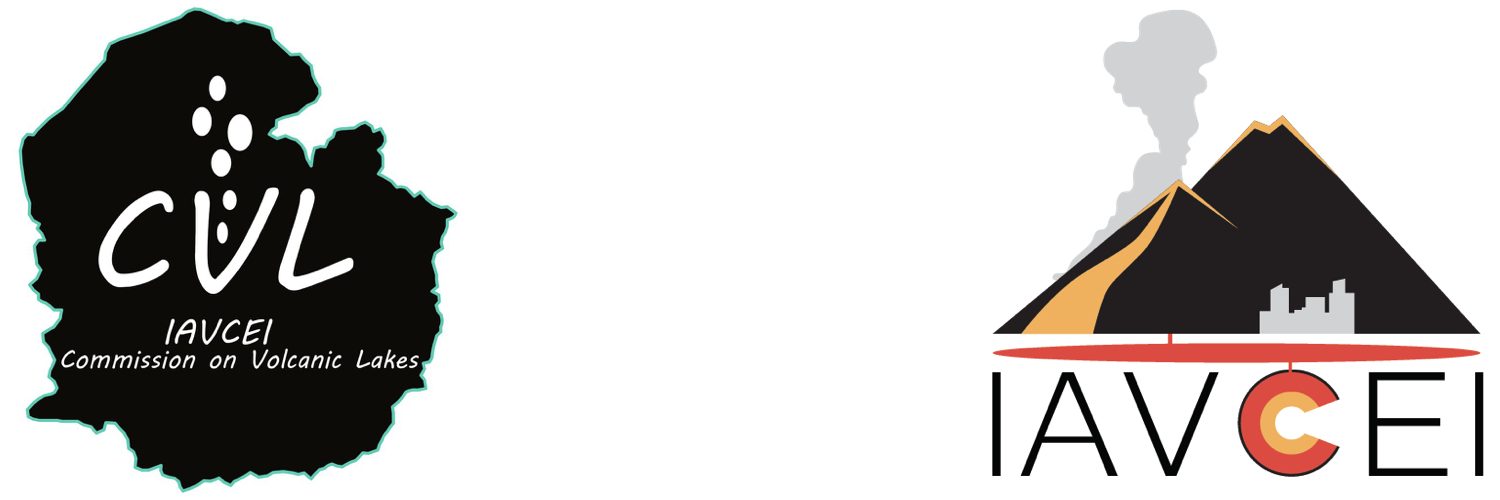The Commission on Volcanic Lakes (CVL) is a scientific, non-profit organization of the International Association of Volcanology and Chemistry of the Earth’s Interior (IAVCEI), connecting researchers that seek to understand how volcanic lakes relate to volcanic activity and their hazards.
Joop C. Varekamp (former CVL Leader) perfectly describes the role of CVL: “The CVL has an important role to play within IAVCEI and a significant scientific mission in volcanology. Volcanic lakes are used to monitor volcanic activity, they harbour their own volcanic dangers (CO2 explosions, lahars, phreatic explosions), and may leak toxic fluids into the surface environment. In addition, they provide “deep blue” windows into the interior of volcanoes and even deeper into the magma source regions, with topical linkages towards ore deposition and geothermal energy development. Reasons enough to pay substantial attention to volcanic lakes. In addition, many global change researchers use volcanic lakes for the study of environmental change. The sedimentary records are influenced both by climatic / hydrological parameters and volcanic inputs, and the expertise of CVL members can contribute to decipher these records. It was the wisdom of the CVL originators to recognize that volcanic lake science is a special field with intertwined aspects of disciplines such as volcanology, limnology, geochemistry, and biology/toxicology.”

To accomplish these goals, to move and promote our scientific object -the volcanic lake- at CVL we believe face-to-face meetings to exchange ideas remains the most efficient way. This has created a familiar environment among people, which on its turn let to new “idées-fixes” and collaborations. CVL organizes triannual workshops, always at a different location, near another volcanic lake or area housing lakes. Following the presentation of several proposals, the site of the “next” workshop CVL10 is chosen democratically within the community. So far, 10 workshops have been organized since 1990.
The quotes below will soon convince you that there are innumerous reasons to deepen our knowledge on volcanic lakes, and… for the CVL community to exist.

Volcanic lakes…
“… are amongst the most spectacular natural features on the planet. These intersections of magmatic-hydrothermal systems and the Earth’s surface are, poetically speaking, ‘blue windows’ into the depth of a volcano.” (Christenson et al. 2015, Volcanic Lakes, Springer)
“… dot the landscape in many volcanic terrains. They range in size from tiny maar lakes to giant caldera lakes”. (Varekamp 2015, Volcanic Lakes, Springer)
“… are surface expressions of the hydrogeology of volcanic complexes.” (Mazza et al. 2015, Volcanic Lakes, Springer)
“… (are permanent when they) meet a combination of physical constraints: (i) the bottom of the lake should be protected against water seepage by physical sealing; (ii) the meteorological precipitation should be abundant (snowfall and its melt water, rainfall); (iii) the input of “volcanic” fluids should be sustained; and (iv) the heat input from the active volcano should be limited, to avoid drying out of the lake by evaporation (Brown et al. 1989, Pasternack and Varekamp 1997).” (Rouwet and Tassi 2011, Ann. Geophys. 54/2)
“… are classified into various groups according to their state of activity, based on their physical and chemical characteristics, such as low-activity to peak-activity lakes and no-activity lakes (Pasternack and Varekamp 1997), and CO2-dominated, quiescent and ‘active’ crater lakes (Varekamp et al. 2000).” (Rouwet and Tassi 2011, Ann. Geophys. 54/2)
“… are studied to monitor the activity of the underlying volcano or dangers associated with the lake itself; (they) provide insight into acid-water/rock interaction or (are) the shallow part of ore-depositing magmatic-hydrotermal systems. Ultimately, volcanic lakes are an expression of terrestrial degassing, and they provide clues to its magnitude.” (Pasternack and Varekamp 1997, Bull. Volcanol. 58)
“… are proto-type settings for (phreatic and phreatomagmatic) activity. Despite the fact that only 8% of the reported volcanic eruptions occurred in a subaqueous setting, they have caused 20% of fatalities (Mastin and Witter 2000). (…) A crater lake or liquid-dominated hydrothermal system, which are strong condensing media, are sensitive to sudden pressure drops when injected by gas-vapor batches, eventually leading to eruptions.” (Rouwet and Morrissey 2015, Volcanic Lakes, Springer)
“… derive their gases from four distinct sources: magmatic, hydrothermal, biospheric and atmospheric.” (Christenson and Tassi 2015, Volcanic Lakes, Springer)
“… provide the advantage to preserve changes in fluid cycling with time, whereas such variations in fumarolic gases from volcano craters will be lost to the atmosphere as a ‘snapshot'”. (Rouwet and Ohba 2015, Volcanic Lakes, Springer)
“… are efficient traps of volcanic volatiles supplied from depth, and a lake’s water composition is considered as an indicator of the flux and composition of supplied volcanic fluids.” (Shinohara et al. 2015, Volcanic Lakes, Springer)

Lake Nyos, Cameroon. picture by D. Rouwet.
“… are known (cfr. Lake Nyos and Lake Monoun, Cameroon) for the dangerous accumulation of CO2 dissolved in stagnant bottom water, but the shallow waters that conceal this hazard are dilute and undergo seasonal changes similar to other deep crater lakes in the tropics.” (Kling et al. 2015, Volcanic Lakes, Springer)
“… can be ‘killer lakes’ (cfr. Lake Nyos and Lake Monoun, Cameroon) (… because they can kill) after a gas explosion or limnic eruption, a sudden release of carbon dioxide accumulated in deep water.” (Kusakabe 2015, Volcanic Lakes, Springer)
“… in the craters of active volcanoes and their related streams are often characterized by conditions considered extreme for life, such as high temperatures, low pH and very high concentrations of dissolved metals and minerals.” (Mapelli et al. 2015, Volcanic Lakes, Springer).

